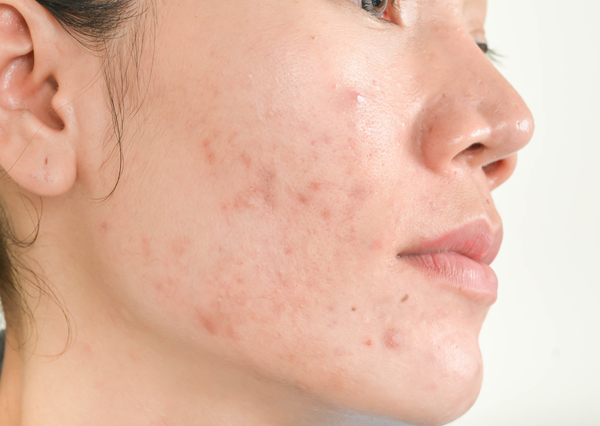Types of Acne Scars

Acne scars may result from a loss of collagen in an area that had acne caused by a strong inflammatory reaction.
Even though many factors can cause scarring, acne scars are more likely to develop if you have cystic acne or pick and pop your active acne lesions. A hands-off policy is best when it comes to dealing with acne.
Causes for Scarring
When acne forms on your skin, your body’s natural healing processes kick in just like they would for an injury or illness. When acne is rooted deep down in the skin, it destroys more of your skin tissue. It takes longer to heal and often leaves scars.
After a breakout, your body will try to heal itself by replacing the lost skin tissue that has been destroyed. Scarring occurs when the body produces too much or too little of this tissue.
When the body creates too much tissue, the acne lesions become raised scars, while the lack of tissue results in skin depressions.
Types of Acne Scars
The most common types of acne scars include:
Atrophic scars – These are shallow pitted scars with smooth borders. An example of atrophic scars includes ice pick scars, which are deep, pitted scars with very sharp borders.
Hypertrophic scars – These are raised scars that are palpable above the skin’s surface. This type of scarring is less common on the face than atrophic scars. These scars tend to occur on the back and chest.
Post-inflammatory Hyperpigmentation
Post-inflammatory hyperpigmentation (PIH) results from increased skin pigment production after an injury or stress on the skin. PIH often forms after an inflammatory reaction in the skin, like acne.
These are the dark marks you sometimes get after a bad outbreak. Technically, they’re not acne scars but a change in skin pigmentation.
When a lesion gets popped or opened up some other way, the skin has to close back together and cover up the depression.
After a particularly deep trauma – like a pit from a popped acne lesion – the body may not be able to heal seamlessly. The skin that closes over the wound will often change color, texture, or tone.
In other cases, the broken blood vessels from a popped lesion leave a mark on your skin. These are what we usually call “dark marks” or hyperpigmentation.
In layman’s terms, PIH is when the skin becomes discolored or darkened in a recently inflamed area. For example, after a painful acne cyst.
Inflammatory acne lesions can cause PIH, particularly in skin of color. PIH can improve with time, but it may linger for 6-12 months or longer without treatment.
Topical prescription medications, such as hydroquinone, azelaic acid, and tazarotene, can be used to improve the appearance of PIH. However, pitted acne scars do not improve much with the use of topical creams alone. Chemical peels and laser treatments, such as the Fractional Erbium Glass laser (Fraxel® laser), are much more effective in treating PIH.
Hereditary Acne
Scar development can be influenced by many things, one of them being genetics. We find that some people are just prone to acne scarring and develop a pitted acne scar from even mild acne. We often see this running in families. For this reason, it is essential to begin an acne-fighting regimen as soon as acne presents and avoid potentially scar-causing breakouts in the future.
Not all patients get scarring, and sometimes it is hard to predict which patient will be left with residual scars from acne. This is why even mild acne must be treated promptly by a dermatologist.
Starting an acne regimen early can eliminate the acne lesions before they lead to scarring. It is also helpful to avoid picking and popping acne at home, as this type of interference may increase the likelihood of scarring.
Factors that Impact Severity of Scarring
Here are some other factors that play a role in whether or not you’ll develop lasting marks after a bad breakout:
Sun Exposure: While intense sun exposure may not directly cause scarring, it can make your acne marks significantly darker and more noticeable.
Puberty: Teenagers tend to develop more acne because of all the hormonal changes in their bodies. And more acne means a higher risk of scarring.
Acne Severity: As you might expect, scarring is directly tied to severity. Scarring is much more likely to occur when acne is more inflamed, more widespread, and more deeply rooted in the skin.
Acne Frequency: Similarly, patients who experience frequent breakouts run a higher risk of scarring.
Gender: While both men and women can develop acne scarring, it tends to be more prominent among men. This is because men tend to develop more severe and persistent acne due to androgens (the male hormones).
Time: The longer you wait before getting treatment, the higher your risk of developing scars. So if just washing your face and keeping your hands off isn’t doing the trick, it may be time to see a dermatologist and get some help.
Numerous factors can impact the severity of your acne scars.
Treating Acne Scars
Your acne scar type will determine which treatment is best for scar removal.
At Schweiger Dermatology Group, we offer a wide variety of acne scar treatments. We find that combination therapy is the most effective approach to minimizing acne scarring.
Acne scars may be treated once the acne is mostly improved, though acne does not need to be completely clear before treatment begins. In fact, for some patients, waiting until their acne is 100% clear could mean that they may never be able to address acne scars.
Schedule a consultation with our experienced, board-certified dermatologists today for a customized acne scar treatment plan to meet your specific needs.
Are you tired of living with acne scars?
We can help! For appointments, call Schweiger Dermatology Group at (844) DERM-DOC.
To find a location near you, check out our location pages. We look forward to working together to find the best acne treatment for your skin!
